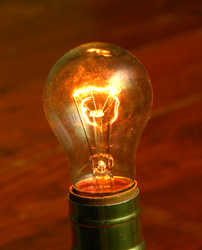Not scared of the dark
How much electricity is used in the United States for lighting homes while people sleep? As I walk or drive around at night, I see many lights left on at all hours. Given the number of lights I see, I suspect they make a fairly significant contribution to residential electricity usage.
So how much energy is used by these lights?
Well, this is easy to calculate.
I must start with an estimate of the power used by these lights. I’ll assume the average household uses 40 watts worth of extra lighting while they are asleep. This is low for some houses in my neighborhood, but also allows for those of us who don’t leave any lights on. Choosing 40 watts also allows for not counting night lights for people who have a good reason to use them.
Now, there are 116,700,000 households in the USA, so at 40 watts per household, night lighting accounts for 4,668,000,000 watts of electricity that is used all night, every night. If we assume 8 hour nights, this lighting is just under 1% residential household electricity consumption. This is a lot of electricity. It is so much that it can be expressed as the number of power plants that are dedicated to providing electricity for night lights in homes.
For the conversion to the number of power plants, I’ll only consider coal power plants, which currently provide over 42% of the electricity generated in the United States, and are largely used to power the base load. There are 1,396 coal power plants operating in the United States, with a combined summer net generating capacity of 316,800,000,000 watts. This means each plant can continuously produce an average of nearly 227,000,000 watts. This means that more than 20 coal power plants are operating all night just to produce light that no one even sees.
Since no one actually uses this light, these extra twenty coal power plants aren’t actually needed. So we have twenty coal power plants that can simply be turned off without any loss to the benefits derived from using electricity they generate.
Not only can every one who is using these extra lights immediately save 1% off their power bill, turning off these unnecessary lights will have immediate quality of life benefits. By not mining and burning the over 7,000,000 tons of coal per year that is used to power these lights, our health and environment will be better than if we continue this unnecessary resource depletion.
It is important to note that the power for these night lights is part of the overnight base load on the power system. The overnight base load is one of the major hurdles in our inevitable move to a solar dominated—and completely renewable—energy system. An analogous contribution to our overnight base load is made by the many lights left on overnight in businesses, schools, and other non-residential buildings.
So, one of the easiest things we can do to improve the use of energy in the United States is to simply turn off night lights that aren’t really being used. If you don’t think there are any lights you can eliminate, consider switching to more efficient bulbs.
See my references and calculations.
